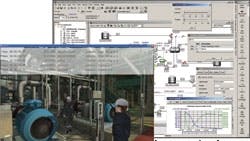In the information age, companies must learn to cut costs, innovate constantly, and make the most of human capital -- all while providing the necessary information to the right people, at the right time. It's not an easy trick.
Factories and facilities, as we know them, are changing at a rapid rate, driven by forces such as new technologies, an evolving workforce, and an economy leaving thinner margins for error.
But according to several industry analysts and consultants, factories and facilities in the future will be shaped by creating a better-trained, more informed workforce that uses new technology to understand the consequences of every action.
"There's too much raw data in plants right now," says Dave Woll, vice president of consulting at ARC Advisory Group. "It needs to be converted into actionable context. I personally believe the definition of operational excellence is the ability to have more people making more of the right decisions."
Just who is making what decisions will become a greater point of concern going forward, says Woll, because the demographics of industry suggest large-scale turnover in the coming years.
"What separates expert operators from others is their experience and judgment," says Woll. "And it takes a long time for younger operators to develop that."
Process simulation technologies combined with virtual reality technologies permit new ways to train employees. Trainees can place themselves in the process virtually, while studying the design and actual layout of a plant.
"Virtual reality is not new," says Tobias Scheele, vice president for advanced applications for Invensys. "It's been used in car manufacturing for years. But it has reached a point now where due to gaming technology, the equipment is affordable, and we can use it to teach operators how to make informed decisions."
Simulation software is only one piece of the broader trend, says ARC's Woll. As automation has increased in factories and plants, system networks have led to the creation of information infrastructures.
Control systems not only control machinery now, says Woll. "They also control an information system as a result of Internet technology moving into the plant. That's what's behind the concept of the common information infrastructure. All the automation in the plant connects directly into a common backbone in exactly the same way you connect your computer into the Internet."
But how the information from those automated systems is exchanged with software in management has been a challenge. Often, the two departments use different software that apply different contexts. Oracle Manufacturing Operations Center is a software platform that integrates data generated on the plant floor with business data normally managed by ERP systems.
According to Michael Grieves, co-director of the Product Lifecycle Management Development Consortium at the University of Michigan's College of Engineering, factories and facilities in the future will need to be able to address customers demanding instant information about their products, or, as he calls them, "virtual products."
"The information about the product in a lot of cases is as important as the product itself," says Grieves. "The trend I've seen is customers wanting that information as it's being manufactured, meaning what its dimensional measurements are and its torque readings. We have the ability to do that now and with the Internet to distribute that information instantaneously. But more customers are going to expect it."
Just as manufacturers have to continually address the shifting landscape of business, they must also show the same capacity to recognize new breakthroughs in technologies and how it can address their operations.
"If you're going to make significant improvements in your plant now or in the future, you've got to accomplish that by changing the way people work," says Woll. "That means changing their work processes and giving them the technology to do their jobs better."
See Also
